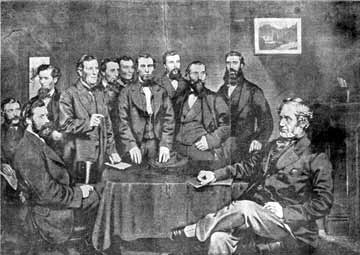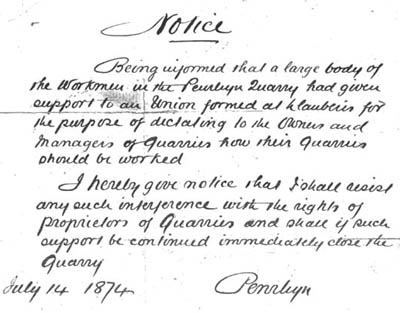Pay, Strikes and Living Conditions - Quarry
Management
Transfer of Power at Penrhyn.
 The first Lord
Penrhyn transferred the management of the quarry to his son and
heir in 1885. Tensions rose to the surface in that year in a
meeting calling for the Disestablishment of the Church in Wales.
Trouble resulted, and the heir to Castell Penrhyn and its estates decided
through his legal representatives to try and discover whom among
his workforce had been involved. The exercise proved futile, but
the quarry workforce were informed, nevertheless, that any
quarryman accused of a breach of the peace would face instant
dismissal. To add insult to injury, this was followed by a
further announcement that the 1874 Pennant Lloyd Agreement was
henceforth a dead letter, since allegedly the state of the slate
market was too low to warrant the payment of the minimum wage.
And on top of it all, it was decided by Lord Penrhyn that every
substantial complaint was to made on an individual basis to the
chief manager, and that any collective representation was
regarded as an attempt to come between the quarry owner and his
workers. The excuse behind this was claimed to be the right of any
non-union member to make his own representations. Three union
members and three non-union members of the workforce sent a
letter of protest. His reaction was to dismiss the three union
members who had deigned to challenge him. True, the three union
members were re-employed three months later, but the seeds of the
festering feeling of antagonism had been sown by the heir, and by
the heir alone. The first Lord
Penrhyn transferred the management of the quarry to his son and
heir in 1885. Tensions rose to the surface in that year in a
meeting calling for the Disestablishment of the Church in Wales.
Trouble resulted, and the heir to Castell Penrhyn and its estates decided
through his legal representatives to try and discover whom among
his workforce had been involved. The exercise proved futile, but
the quarry workforce were informed, nevertheless, that any
quarryman accused of a breach of the peace would face instant
dismissal. To add insult to injury, this was followed by a
further announcement that the 1874 Pennant Lloyd Agreement was
henceforth a dead letter, since allegedly the state of the slate
market was too low to warrant the payment of the minimum wage.
And on top of it all, it was decided by Lord Penrhyn that every
substantial complaint was to made on an individual basis to the
chief manager, and that any collective representation was
regarded as an attempt to come between the quarry owner and his
workers. The excuse behind this was claimed to be the right of any
non-union member to make his own representations. Three union
members and three non-union members of the workforce sent a
letter of protest. His reaction was to dismiss the three union
members who had deigned to challenge him. True, the three union
members were re-employed three months later, but the seeds of the
festering feeling of antagonism had been sown by the heir, and by
the heir alone.
The man from London came - 1886
As the old lord aged, it became increasingly apparent to his son that efficiency in the running of the quarry
was sorely lacking. In 1886, a year after taking over the
administration of the quarry, and the year when he became the
second Lord Penrhyn, a new chief manager was appointed in place
of Arthur Wyatt. His name was Emilius Alexander Young.
A member of the London firm of accountants Turquand, Young &
Co., there is no doubt as to E.A. Young's ability as an
accountant and financial advisor. The second Lord Penrhyn's
wish was to secure complete dominance over his workers at the
Bethesda Quarry. Both he and Young were on the same wavelength,
because as far as Young was concerned this went hand in hand
with sound business sense. And so was founded an alliance that
would in the course of time make Bethesda and the Penrhyn Quarry
a Waterloo in the quarrying world. Indeed, for a few years Penrhynism became a new word in the English language until
Kaiserism and Hitlerism superseded it. But since it was the name
of E.A.Young that appeared at the bottom of every poster during
the industrial disputes from 1886 onwards, rather than Penrhyn, it follows that it was
Young who was happily and thoroughly despised during
the dispute. But from the second Lord Penrhyn's actions in 1885,
it cannot be ignored that he had a very subservient ear in the
person of Emilius Alexander Young. Common gossip still holds in
Bethesda that Young was buried in the depths of a mid September
night. In truth, he was buried on a sunny Saturday afternoon in
September at Llandygai. However, a search for his tombstone has
been unfruitful.

|